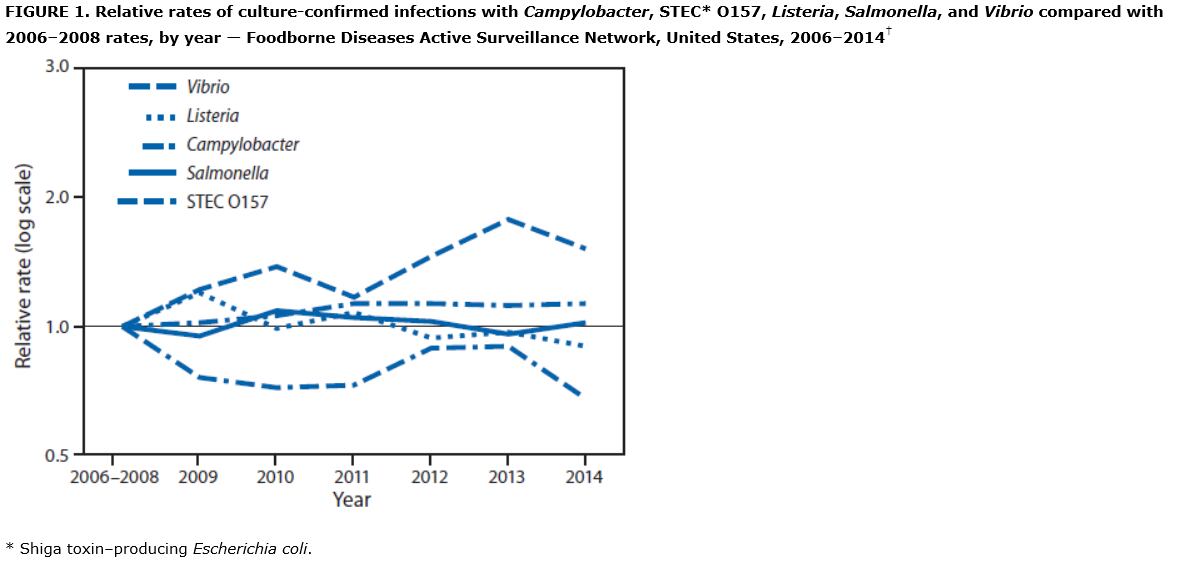Laboratory-confirmed Shiga toxin–producing E. coli (STEC) O157 and Salmonella Typhimurium infections dropped but Campylobacter, Vibrio, STEC non-O157 and other Salmonella strains have increased while Listeria stayed around the same level.
Success and challenges
Dr Patricia Griffin, chief of Enteric Diseases Epidemiology Branch in CDC's division of foodborne, waterborne and environmental diseases, said the data shows success but also major challenges.
“We think that we will need targeted interventions to decrease Salmonella illnesses, we are excited about the opportunity the whole genome sequencing is providing to help us better figure out the sources of people's illnesses and FoodNet will continue to track illnesses so we can measure trends in foodborne infections, to track whether prevention measures are working.”
Data comes from FoodNet, CDC’s surveillance system that tracks nine foodborne pathogens in 10 states and monitors trends in foodborne illness in about 15% of the population.
It covers 2014 and makes a comparison with the baseline period of 2006-2008.
STEC decline
Infection with STEC decreased 32% compared with 2006-2008 and 19% from the most recent three years.
A reason for the decline could be because isolates are routinely sent to public health departments for subtyping by PulseNet and epidemiologists investigate clusters of illnesses in which bacteria have similar DNA fingerprints, the sources of outbreaks are identified faster which allows contaminated products to be removed from sale before more people become ill.
"We are encouraged by the reduction of STEC O157:H7 illnesses, which reflects our science-based approach to beef inspection, and we look forward to seeing further reductions in Salmonella and Campylobacter infections as our improved standards for poultry take effect later this year, " said Al Almanza, Deputy Under Secretary for Food Safety at USDA.

Salmonella varied
Salmonella Typhimurium was 27% lower than 2006-2008, continuing a downward trend begun in the mid-1980s.
Two other less common types, Javiana and Infantis, more than doubled for unknown reasons.
However, when all Salmonella serotypes are combined, there was no change in 2014 from 38%.
In January 2015, USDA-FSIS proposed pathogen-reduction performance standards for Salmonella and Campylobacter in comminuted (reduced to minute particles) chicken and turkey products
The FDA also plans to publish regulations for safer produce, processed foods, and imported foods, as mandated by the Food Safety Modernization Act.
Campylobacter increased 13% and Vibrio went up 52% against 2006-2008.
FoodNet helps direct energies and resources
Kathleen Gensheimer, director and chief medical officer of FDA's coordinated outbreak response and evaluation (CORE) team, said the goal under FSMA is to move to a preventative approach.
“Even foods not previously implicated in outbreaks need to be covered, because we never know when that first outbreak will happen, nor do we always appreciate or understand what the next microbial niche will be in our food safety supply,” she said.
“The recent outbreak of Listeria monocytogenes attributed to caramel apples that we all saw across the media and affecting several individuals nationwide last fall and into the winter, are certainly a good example of a new, emerging entity.”
Last year, FoodNet logged just over 19,000 infections, about 4,400 hospitalizations, and 71 deaths from the nine foodborne germs it tracks.
Salmonella and Campylobacter accounted for about 14,000 of the 19,000 infections reported.
